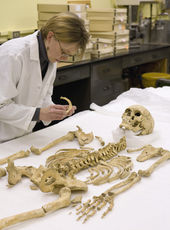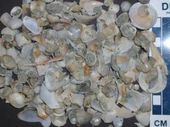It's a tale of toil, starvation and death, set forth in messages from the grave.

© AP Photo/Smithsonian, Chip ClarkForensic anthropologist Karin Bruwelheide examining a 17th century skeleton from the Leavy Neck site, Anne Arundel County, Md., part of an exhibit, The saga of life in 17th century America.
The saga of life in 17th century America -- "Written in Bone" -- goes on display Saturday at the Smithsonian's National Museum of Natural History.
Some 340 objects, including artifacts and human bones, are on display for two years, with discussions of how cold cases from colonial times shed light on what life was like for some of the earliest English and Africans to settle in America.
The exhibit is "a fascinating window into the lives of our nation's earliest colonists," observed museum director Cristian Samper.
Since 1992 researchers have unearthed the remains of hundreds of early settlers around Chesapeake Bay.
"Now we can get to know these individuals, learn about how they lived and sometimes how they died," said forensic anthropologist Douglas Owsley, curator of the exhibit.



